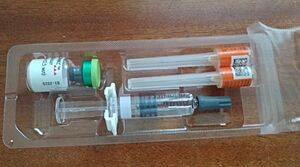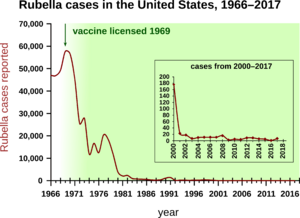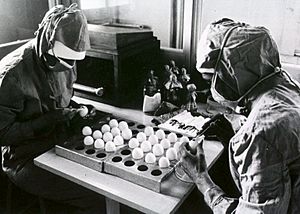MMR vaccine facts for kids
The MMR vaccine is a special shot that protects you from three common childhood diseases: measles, mumps, and rubella (also known as German measles). The letters "MMR" stand for these three diseases.
Usually, children get their first MMR shot when they are around 9 to 15 months old. A second shot is given later, often between 15 months and 6 years of age. There should be at least four weeks between the two doses. After getting both shots, most people are well-protected: about 97% against measles, 88% against mumps, and at least 97% against rubella.
This vaccine is also suggested for people who haven't had these diseases or the vaccine before. It's even safe for people with well-managed HIV/AIDS. If someone has been near a person with measles and hasn't had all their shots, they might get the vaccine within 72 hours to help prevent getting sick. The MMR vaccine is given as an injection.
The MMR vaccine is used all over the world. Between 1999 and 2004, over 500 million doses were given. Before this vaccine became common, measles caused about 2.6 million deaths each year. By 2012, this number dropped to 122,000 deaths per year, mostly in poorer countries. Thanks to vaccination, measles rates in North and South America are now very low. When people don't get vaccinated, these diseases can spread more easily. From 2000 to 2018, the measles vaccine helped reduce measles deaths by 73%.
Side effects from the MMR vaccine are usually mild. They often go away on their own without special treatment. You might get a fever, or feel some pain or see redness where you got the shot. Very serious allergic reactions are extremely rare, happening in about one out of a million people.
Because the MMR vaccine contains weakened live viruses, it's not usually given during pregnancy. However, it is safe to get if you are breastfeeding. It's also safe to get the MMR vaccine at the same time as other vaccines. Getting the vaccine does not make you more likely to spread measles, mumps, or rubella to others.
There is no scientific proof that the MMR vaccine causes autism. Many studies have looked into this, and they all agree there is no link. The MMR vaccine is made from weakened versions of the measles, mumps, and rubella viruses.
The MMR vaccine was created by a scientist named Maurice Hilleman. It was first approved for use in the US by Merck in 1971. Before that, separate vaccines for measles, mumps, and rubella were available. Doctors started recommending a second dose of the MMR vaccine in 1989. There's also an MMRV vaccine which includes protection against chickenpox, and sometimes an MR vaccine which only covers measles and rubella.
Contents
Why the MMR Vaccine is Important
Experts agree that the MMR vaccine is very important. It helps prevent serious illnesses and deaths from measles, mumps, and rubella. Getting the combined MMR vaccine is less painful than getting three separate shots at the same time. It also protects you faster and more effectively. In England, offering the combined vaccine instead of separate shots helped more people get vaccinated.
Protecting Against Measles
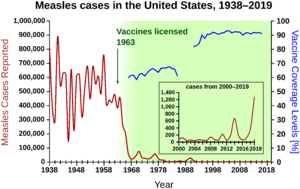
Before the measles vaccine, measles was so common that almost everyone got it. In the United States, reported cases of measles dropped from hundreds of thousands to tens of thousands after the vaccine came out in 1963. After more people got vaccinated, the numbers dropped even further. An outbreak in 1990 led to a stronger push for vaccination and adding a second dose. Since 1997, there have been very few measles cases in the US each year. The disease is no longer considered to be always present there.
The measles vaccine has saved many lives and prevented much suffering. In its first 20 years in the US, it stopped an estimated 52 million cases of measles. It also prevented 17,400 cases of intellectual disability and 5,200 deaths. Between 1999 and 2004, efforts by the World Health Organization and UNICEF helped prevent about 1.4 million measles deaths worldwide. From 2000 to 2018, measles vaccination led to a 73% drop in deaths from the disease.
Measles is still common in many parts of the world. Even though it was declared eliminated from the US in 2000, high vaccination rates are needed to keep it from coming back. In 2005, one unvaccinated person who got measles in Romania caused an outbreak in the US. This person returned to a community with many unvaccinated children. The outbreak infected 34 people, mostly unvaccinated children. It cost a lot of money to control, but a major epidemic was avoided because most people in nearby communities were vaccinated.
In 2017, there was a measles outbreak in Minnesota among a community where MMR vaccination rates had dropped. This happened because of a false idea that the vaccine caused autism. The US Centers for Disease Control and Prevention reported 65 affected children in that outbreak.
Protecting Against Rubella
Rubella, or German measles, was also very common before the vaccine. The biggest danger of rubella is for pregnant women. If a pregnant woman gets rubella, her baby can be born with serious problems called congenital rubella syndrome.
Protecting Against Mumps
Mumps is another viral disease that used to be very common, especially in children. If a boy or man gets mumps after puberty, it can sometimes cause problems with having children later on.
How the Vaccine is Given
The MMR vaccine is given as a shot just under the skin. The first dose is usually given around 12 months of age. The second dose can be given as early as one month after the first. This second dose helps protect the small number of people (2–5%) who didn't become fully immune after the first shot. In the US, the second dose is often given before children start kindergarten because it's a convenient time. In areas where measles is very common, the first dose is often given at nine months and the second at fifteen months.
Safety of the MMR Vaccine
Side effects from the MMR vaccine are rare and usually not serious. About 10% of children might get a fever, feel unwell, or develop a rash 5–21 days after their first shot. About 3% might have joint pain for about 18 days. Older women seem to have a slightly higher risk of joint pain. A very rare but serious allergic reaction called anaphylaxis can happen. One reason for this can be a severe egg allergy.
In 2014, the FDA (Food and Drug Administration) approved adding two very rare possible side effects to the vaccine's information: acute disseminated encephalomyelitis (ADEM) and transverse myelitis. They also allowed adding "difficulty walking." A 2012 report found that the measles part of the MMR vaccine can cause a rare brain infection in people with very weak immune systems. This report also confirmed there is no link between the MMR vaccine and autism. Some versions of the vaccine contain the antibiotic neomycin, so people allergic to this antibiotic should not use them.
Reports of serious brain or nerve problems are very few. One type of MMR vaccine, which used a specific mumps strain called Urabe, was linked to a rare, mild form of aseptic meningitis (a type of viral meningitis). The UK National Health Service stopped using this strain in the early 1990s and switched to a different one called Jeryl Lynn. The Urabe strain is still used in some countries because it's cheaper to make.
A review of studies found that compared to a fake shot, the MMR vaccine was linked to fewer upper respiratory infections. It was also linked to more fussiness in babies, but a similar number of other side effects.
Measles itself can sometimes cause a bleeding problem called immune thrombocytopenic purpura (ITP) in about 1 in 20,000 cases. About 1 in 40,000 children might get ITP in the six weeks after an MMR vaccination. ITP in young children is usually mild and rarely causes long-term problems.
False Claims About Autism
There have been false claims that the MMR vaccine causes autism. In 1998, a doctor named Andrew Wakefield published a paper claiming a link between the MMR vaccine and autism. However, this paper was later found to be based on dishonest research. In 2010, the medical journal The Lancet completely took back the paper because it was found to be fraudulent. Wakefield was then stopped from practicing medicine in the UK because he had deliberately falsified his research. The British Medical Journal also declared his research fraudulent in 2011.
Since Wakefield's paper, many scientific studies have been done. None of them have found any link between the MMR vaccine and autism. Major health organizations like the US Centers for Disease Control and Prevention, the Institute of Medicine, the UK National Health Service, and the Cochrane Library have all stated there is no evidence of a link.
Giving the vaccines in three separate shots does not reduce the chance of side effects. In fact, it increases the risk of getting sick from the diseases you haven't been vaccinated against yet. Experts have criticized how some media reported on the MMR-autism controversy. This reporting caused vaccination rates to drop. Before Wakefield's article, 92% of children in the UK got the MMR vaccine. After the article, the rate dropped below 80%. In 1998, there were 56 measles cases in the UK. By 2008, there were 1348 cases, and two people died.
In Japan, they don't use the combined MMR vaccine. Instead, they use a vaccine for measles and rubella, and then a separate mumps vaccine later. This has not changed the rates of autism in Japan, which further shows that the idea of the MMR vaccine causing autism is false.
History of the Vaccine
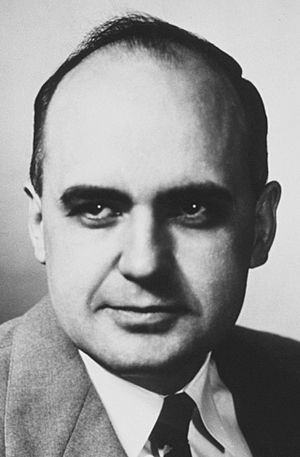
The viruses used in the MMR vaccine were grown in animal and human cells. For example, the measles and mumps viruses were grown in chicken eggs. This made the viruses adapt to chicken cells, making them weaker and less harmful to human cells. These are called attenuated strains, meaning they are weakened.
The rubella part of the vaccine, called Meruvax, was developed in 1967. It was grown using human cells from a cell line called WI-38.
The MMR vaccine is supplied as a freeze-dried powder. Before it's injected, it's mixed with a special liquid.
Some brands of the MMR vaccine, like Pluserix and Priorix, use different weakened strains of the measles, mumps, and rubella viruses.
MMRV Vaccine
The MMRV vaccine is a combined vaccine that protects against measles, mumps, rubella, and varicella (chickenpox). It was created to make it simpler to get all these protections in one shot. However, early information showed that the MMRV vaccine might cause a slightly higher rate of febrile seizures (fever fits) compared to getting separate MMR and chickenpox shots. Because of this, health officials in the US don't prefer the MMRV vaccine over separate shots.
A 2012 study found that many doctors were not aware of the slightly higher risk of fever fits with the MMRV vaccine. After learning about it, fewer doctors recommended the MMRV for young children.
MR Vaccine
This is a vaccine that covers measles and rubella, but not mumps. As of 2014, it was used in a few countries.
Society and Culture
Religious Concerns
Some brands of the MMR vaccine use gelatin, which comes from pigs, to help keep the vaccine stable. This has caused some people from certain religious communities to be hesitant about getting the vaccine. However, there are other vaccines available that do not use pig products.


